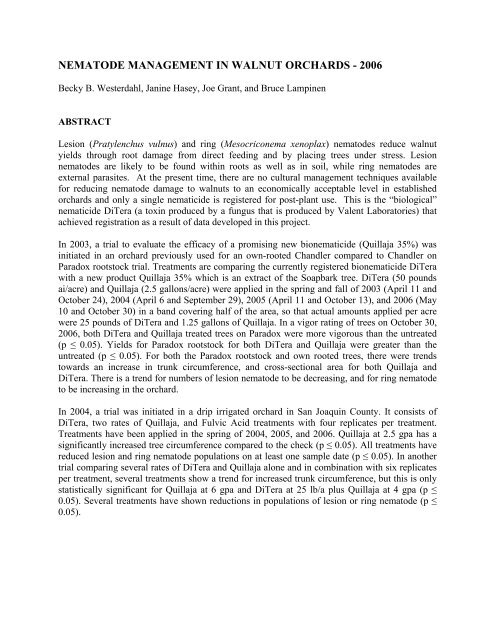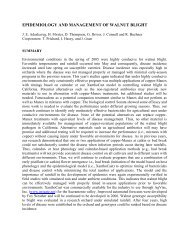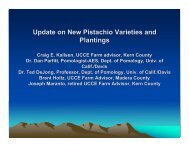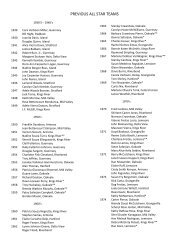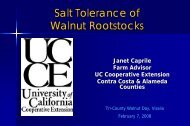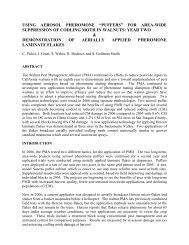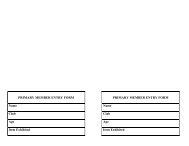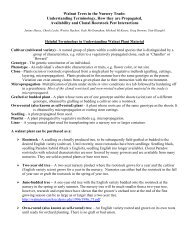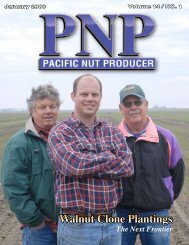nematode management in walnut orchards - Walnut Research Reports
nematode management in walnut orchards - Walnut Research Reports
nematode management in walnut orchards - Walnut Research Reports
You also want an ePaper? Increase the reach of your titles
YUMPU automatically turns print PDFs into web optimized ePapers that Google loves.
NEMATODE MANAGEMENT IN WALNUT ORCHARDS - 2006<br />
Becky B. Westerdahl, Jan<strong>in</strong>e Hasey, Joe Grant, and Bruce Lamp<strong>in</strong>en<br />
ABSTRACT<br />
Lesion (Pratylenchus vulnus) and r<strong>in</strong>g (Mesocriconema xenoplax) <strong>nematode</strong>s reduce <strong>walnut</strong><br />
yields through root damage from direct feed<strong>in</strong>g and by plac<strong>in</strong>g trees under stress. Lesion<br />
<strong>nematode</strong>s are likely to be found with<strong>in</strong> roots as well as <strong>in</strong> soil, while r<strong>in</strong>g <strong>nematode</strong>s are<br />
external parasites. At the present time, there are no cultural <strong>management</strong> techniques available<br />
for reduc<strong>in</strong>g <strong>nematode</strong> damage to <strong>walnut</strong>s to an economically acceptable level <strong>in</strong> established<br />
<strong>orchards</strong> and only a s<strong>in</strong>gle nematicide is registered for post-plant use. This is the “biological”<br />
nematicide DiTera (a tox<strong>in</strong> produced by a fungus that is produced by Valent Laboratories) that<br />
achieved registration as a result of data developed <strong>in</strong> this project.<br />
In 2003, a trial to evaluate the efficacy of a promis<strong>in</strong>g new bionematicide (Quillaja 35%) was<br />
<strong>in</strong>itiated <strong>in</strong> an orchard previously used for an own-rooted Chandler compared to Chandler on<br />
Paradox rootstock trial. Treatments are compar<strong>in</strong>g the currently registered bionematicide DiTera<br />
with a new product Quillaja 35% which is an extract of the Soapbark tree. DiTera (50 pounds<br />
ai/acre) and Quillaja (2.5 gallons/acre) were applied <strong>in</strong> the spr<strong>in</strong>g and fall of 2003 (April 11 and<br />
October 24), 2004 (April 6 and September 29), 2005 (April 11 and October 13), and 2006 (May<br />
10 and October 30) <strong>in</strong> a band cover<strong>in</strong>g half of the area, so that actual amounts applied per acre<br />
were 25 pounds of DiTera and 1.25 gallons of Quillaja. In a vigor rat<strong>in</strong>g of trees on October 30,<br />
2006, both DiTera and Quillaja treated trees on Paradox were more vigorous than the untreated<br />
(p ≤ 0.05). Yields for Paradox rootstock for both DiTera and Quillaja were greater than the<br />
untreated (p ≤ 0.05). For both the Paradox rootstock and own rooted trees, there were trends<br />
towards an <strong>in</strong>crease <strong>in</strong> trunk circumference, and cross-sectional area for both Quillaja and<br />
DiTera. There is a trend for numbers of lesion <strong>nematode</strong> to be decreas<strong>in</strong>g, and for r<strong>in</strong>g <strong>nematode</strong><br />
to be <strong>in</strong>creas<strong>in</strong>g <strong>in</strong> the orchard.<br />
In 2004, a trial was <strong>in</strong>itiated <strong>in</strong> a drip irrigated orchard <strong>in</strong> San Joaqu<strong>in</strong> County. It consists of<br />
DiTera, two rates of Quillaja, and Fulvic Acid treatments with four replicates per treatment.<br />
Treatments have been applied <strong>in</strong> the spr<strong>in</strong>g of 2004, 2005, and 2006. Quillaja at 2.5 gpa has a<br />
significantly <strong>in</strong>creased tree circumference compared to the check (p ≤ 0.05). All treatments have<br />
reduced lesion and r<strong>in</strong>g <strong>nematode</strong> populations on at least one sample date (p ≤ 0.05). In another<br />
trial compar<strong>in</strong>g several rates of DiTera and Quillaja alone and <strong>in</strong> comb<strong>in</strong>ation with six replicates<br />
per treatment, several treatments show a trend for <strong>in</strong>creased trunk circumference, but this is only<br />
statistically significant for Quillaja at 6 gpa and DiTera at 25 lb/a plus Quillaja at 4 gpa (p ≤<br />
0.05). Several treatments have shown reductions <strong>in</strong> populations of lesion or r<strong>in</strong>g <strong>nematode</strong> (p ≤<br />
0.05).
OBJECTIVES<br />
1. Optimize sampl<strong>in</strong>g strategies and treatment tim<strong>in</strong>g for lesion and r<strong>in</strong>g <strong>nematode</strong> on <strong>walnut</strong>s<br />
<strong>in</strong> a San Joaqu<strong>in</strong> County Orchard.<br />
2. Evaluate performance of Quillaja 35% and DiTera <strong>in</strong> a Sutter County orchard.<br />
3. Evaluate performance of Quillaja 35%, DiTera, and Fulvic Acid <strong>in</strong> a San Joaqu<strong>in</strong> County<br />
orchard.<br />
4. Evaluate performance of bionematicides <strong>in</strong> a Solano County orchard.<br />
PROCEDURES<br />
Lesion (Pratylenchus vulnus) and r<strong>in</strong>g (Mesocriconema xenoplax) <strong>nematode</strong>s reduce <strong>walnut</strong><br />
yields through root damage from direct feed<strong>in</strong>g and by plac<strong>in</strong>g trees under stress (Lownsbery,<br />
1956 and 1959; Lownsbery et al., 1978). Lesion <strong>nematode</strong>s are likely to be found with<strong>in</strong> roots<br />
as well as <strong>in</strong> soil, while r<strong>in</strong>g <strong>nematode</strong>s are external parasites. At the present time, there are no<br />
cultural <strong>management</strong> techniques available for reduc<strong>in</strong>g <strong>nematode</strong> damage to <strong>walnut</strong>s to an<br />
economically acceptable level <strong>in</strong> established <strong>orchards</strong> and only a s<strong>in</strong>gle nematicide is registered<br />
for post-plant use. This is the “biological” nematicide DiTera (a tox<strong>in</strong> produced by a fungus that<br />
is produced by Valent Laboratories) that achieved registration as a result of data developed <strong>in</strong><br />
this project. Quillaja 35% which is an extract of the Soapbark tree is another promis<strong>in</strong>g<br />
bionematicide. Desert K<strong>in</strong>g is actively pursu<strong>in</strong>g registration of the product with both CA and US<br />
EPA and there is promis<strong>in</strong>g efficacy data on grapes and tomatoes <strong>in</strong> Chile.<br />
1. Optimize sampl<strong>in</strong>g strategies and treatment tim<strong>in</strong>g for lesion and r<strong>in</strong>g <strong>nematode</strong> on <strong>walnut</strong>s<br />
<strong>in</strong> a San Joaqu<strong>in</strong> County Orchard.<br />
A trial with 17 treatments (Table 1) is <strong>in</strong> progress to evaluate whether reduced rates (25 and 12.5<br />
vs 50 pounds/acre) of the bionematicde DiTera will be effective <strong>in</strong> controll<strong>in</strong>g lesion and r<strong>in</strong>g<br />
<strong>nematode</strong>s; to evaluate four rates of Quillaja 35% (6, 4, 2.5, and 1.25 gallons/acre); and to<br />
evaluate the effectiveness of comb<strong>in</strong>ations of DiTera and Quillaja (50 lb/a + 4 gpa, 50 lb/a + 2.5<br />
gpa, 25 lb/a + 4 gpa, 25 lb/a + 2.5 gpa, 12.5 lb/a + 4 gpa, 12.5 lb/a + 2.5 gpa). This is a<br />
randomized complete block trial with six replicates per treatment. Treatments <strong>in</strong>clude an<br />
untreated check and treatment effectiveness is be<strong>in</strong>g evaluated via soil and root sampl<strong>in</strong>g, and<br />
trunk circumference measurements. The 50 lb/acre DiTera treatment was applied either once <strong>in</strong><br />
the spr<strong>in</strong>g of 2004 (DiTera 50) or 2005, (DiTera 0 + 50), or <strong>in</strong> the spr<strong>in</strong>g of both years (DiTera<br />
50 + 50). All of the other treatments were applied <strong>in</strong> the spr<strong>in</strong>g of 2005.<br />
Data is be<strong>in</strong>g analyzed us<strong>in</strong>g analysis of variance followed by <strong>in</strong>dependent contrasts for mean<br />
separation or Fisher’s Protected Least Significant Difference Test.<br />
Nematodes are extracted from soil via elutriation-sugar centrifugation and from roots via mist<br />
chamber extraction. In elutriation-sugar centrifugation, a measured volume of soil is mixed with<br />
a larger volume of water, and poured through a f<strong>in</strong>e mesh sieve which reta<strong>in</strong>s the <strong>nematode</strong>s.
Nematodes washed from the sieve are then mixed with a sugar solution <strong>in</strong> a plastic tube and<br />
centrifuged. Dur<strong>in</strong>g this process, <strong>nematode</strong>s float <strong>in</strong> the sugar solution while any rema<strong>in</strong><strong>in</strong>g soil<br />
particles are pulled to the bottom by the centrifugation. Nozzles at the top of a mist chamber<br />
periodically spray heated water on roots held <strong>in</strong> a mesh basket nested on top of a funnel. The<br />
stem of the funnel resides <strong>in</strong> a test-tube. Nematodes emerge from the roots and are captured at<br />
the bottom of the test-tube while excess water flows over the top of the tube. For both<br />
techniques, extracted <strong>nematode</strong>s are then counted under a microscope.<br />
2. Evaluate performance of Quillaja 35% and DiTera <strong>in</strong> a Sutter County orchard.<br />
The study site is located <strong>in</strong> Sutter County <strong>in</strong> northern California on Holillipah loamy sand. Two<br />
rootstocks, micropropagated ‘Chandler’ on its own-roots and nursery grafted ‘Chandler’ on<br />
seedl<strong>in</strong>g Paradox rootstock were planted <strong>in</strong> 1991 <strong>in</strong> a randomized complete block design spaced<br />
at 25 ft x 25 ft. Trees are irrigated us<strong>in</strong>g microspr<strong>in</strong>klers.<br />
The nematicide trial has 10 <strong>in</strong>dividual tree replicates per treatment (5 Paradox and 5 own-rooted)<br />
for DiTera DF and Quillaja 35% <strong>in</strong> a randomized complete block design. In addition, a new<br />
formulation of DiTera is be<strong>in</strong>g evaluated on 2 Paradox and 5 own-rooted trees. Treatments were<br />
applied <strong>in</strong> 2003 (April 11 and October 24), 2004 (April 6 and September 29), 2005 (April 11 and<br />
October 13), and 2006 (May 10 and October 30) <strong>in</strong> a band cover<strong>in</strong>g half of the area, so that<br />
actual amounts applied per acre were 25 pounds of DiTera and 1.25 gallons of Quillaja.<br />
Treatments are <strong>in</strong>corporated with irrigation. The new formulation of DiTera was not applied to<br />
both rootstocks on all dates due to <strong>in</strong>sufficient product be<strong>in</strong>g available. Data for the new<br />
formulation has not been <strong>in</strong>cluded <strong>in</strong> the figures.<br />
Root and soil samples are taken prior to each treatment date us<strong>in</strong>g a 5 cm bucket auger to a depth<br />
of 60 cm midway between the dripl<strong>in</strong>e and tree trunk <strong>in</strong> the fall and spr<strong>in</strong>g of each year.<br />
Nematodes were extracted from a 400 cm 3 soil sub-sample with a modified semiautomatic<br />
elutriator and sucrose centrifugation technique (Byrd et al., 1976). Data were analyzed us<strong>in</strong>g<br />
analysis of variance followed by <strong>in</strong>dependent contrasts for mean separation or Fisher’s Protected<br />
Least Significant Difference Test.<br />
3. Evaluate performance of Quillaja 35%, DiTera, and Fulvic Acid <strong>in</strong> a San Joaqu<strong>in</strong> County<br />
orchard.<br />
In 2004, a trial was <strong>in</strong>itiated <strong>in</strong> a drip irrigated orchard <strong>in</strong> San Joaqu<strong>in</strong> County. It consists of<br />
DiTera, two rates of Quillaja (2.5 and 4 gpa), and Fulvic Acid treatments with four replicates per<br />
treatment. Treatments have been applied <strong>in</strong> the spr<strong>in</strong>g of 2004, 2005, and 2006. Treatments are<br />
applied through the drip irrigation system. Treatment effectiveness is be<strong>in</strong>g evaluated via soil<br />
and root sampl<strong>in</strong>g, and trunk circumference measurements. Data is be<strong>in</strong>g analyzed us<strong>in</strong>g<br />
analysis of variance followed by <strong>in</strong>dependent contrasts for mean separation.
4. Evaluate performance of bionematicides <strong>in</strong> a Solano County orchard.<br />
In 2006, three trials were <strong>in</strong>itiated <strong>in</strong> an 8-acre block of third leaf <strong>walnut</strong>s at Lester Farms that<br />
has a high population of lesion and r<strong>in</strong>g <strong>nematode</strong>. In the first trial, the large size of the trial area<br />
available is allow<strong>in</strong>g for larger size replicates (30 trees/rep) than <strong>in</strong> our previous trials and<br />
products are be<strong>in</strong>g applied with the grower’s application equipment. The treatments are DiTera<br />
at 25 pounds/acre, Quillaja 35% at 6 gpa and an untreated uncontrol. The trial is be<strong>in</strong>g conducted<br />
<strong>in</strong> a randomized block design with 5 replicates per treatment.<br />
The second trial is be<strong>in</strong>g conducted to test newly available products and consists of ten<br />
treatments, conducted <strong>in</strong> a randomized complete block design with 6 replicates per treatment,<br />
each consist<strong>in</strong>g of a s<strong>in</strong>gle tree. The treatments are an untreated control, two new formulations<br />
of DiTera, an additional new product from Valent, three products from Stoller (ST008, ST007,<br />
and X-Tra Power), Quillaja alone, Quillaja plus Yucca, and DiTera.<br />
The third trial is be<strong>in</strong>g conducted to determ<strong>in</strong>e if frequency or time of the year products are<br />
applied affects efficacy of control. It consists of 16 treatments <strong>in</strong>clud<strong>in</strong>g a control, conducted <strong>in</strong> a<br />
randomized complete block design with 6 replicates per treatment, each consist<strong>in</strong>g of a s<strong>in</strong>gle<br />
tree. DiTera at 25 pounds/acre is be<strong>in</strong>g applied from 1 to 4 times a year, with applications<br />
start<strong>in</strong>g at different times of the year.<br />
RESULTS AND DISCUSSION<br />
1. Optimize sampl<strong>in</strong>g strategies and treatment tim<strong>in</strong>g for lesion and r<strong>in</strong>g <strong>nematode</strong> on <strong>walnut</strong>s<br />
<strong>in</strong> a San Joaqu<strong>in</strong> County Orchard.<br />
In this trial, several treatments show a trend for <strong>in</strong>creased trunk circumference, but this is only<br />
statistically significant for Quillaja at 6 gpa and DiTera at 25 lb/a plus Quillaja at 4 gpa (p ≤<br />
0.05) (Figure 1). Several treatments have shown reductions <strong>in</strong> populations of lesion or r<strong>in</strong>g<br />
<strong>nematode</strong> (p ≤ 0.05) (Table 1).<br />
2. Evaluate performance of Quillaja 35% and DiTera <strong>in</strong> a Sutter County orchard.<br />
In a vigor rat<strong>in</strong>g of trees on October 30, 2006 that was based on the current years growth, both<br />
DiTera and Quillaja treated trees appeared more vigorous than the untreated, although the<br />
untreated seemed to also have improved s<strong>in</strong>ce the 2005 vigor rat<strong>in</strong>g. Statistically, both DiTera<br />
and Quillaja treated trees on Paradox were more vigorous than the untreated (p ≤ 0.05), as were<br />
the DiTera treated trees on own-root (p = 0.08) (Figure 2). Yields for Paradox rootstock for both<br />
DiTera and Quillaja were greater than the untreated (p ≤ 0.05) (Figure 3). Although not<br />
statistically significant, for both rootstocks, there were trends towards an <strong>in</strong>crease of the<br />
difference <strong>in</strong> yield from 2003 to 2006 (Figure 4), <strong>in</strong> trunk circumference (Figure 5), and crosssectional<br />
area (Figure 6) for both Quillaja and DiTera. Quality data were obta<strong>in</strong>ed for this trial,<br />
but were not yet available for presentation <strong>in</strong> this report. In spite of the yield <strong>in</strong>creases and<br />
improvements <strong>in</strong> vigor, over the course of the trial, there have not been significant reductions <strong>in</strong><br />
<strong>nematode</strong> populations. Overall, there is a trend for numbers of lesion <strong>nematode</strong> to be decreas<strong>in</strong>g,
and for r<strong>in</strong>g <strong>nematode</strong> to be <strong>in</strong>creas<strong>in</strong>g <strong>in</strong> the orchard (Table 2). In one case for lesion <strong>nematode</strong>,<br />
and <strong>in</strong> several <strong>in</strong>stances for r<strong>in</strong>g <strong>nematode</strong>, population <strong>in</strong>creases have been observed (p ≤ 0.05).<br />
This could be an <strong>in</strong>dication of the development of a more vigorous root system capable of<br />
support<strong>in</strong>g more <strong>nematode</strong>s.<br />
3. Evaluate performance of Quillaja 35%, DiTera, and Fulvic Acid <strong>in</strong> a San Joaqu<strong>in</strong> County<br />
orchard.<br />
In this trial, Quillaja at 2.5 gpa has a significantly <strong>in</strong>creased tree circumference compared to the<br />
check (p ≤ 0.05) (Figure 7). All treatments have reduced lesion and r<strong>in</strong>g <strong>nematode</strong> populations<br />
on at least one sample date (p ≤ 0.05) (Table 3).<br />
4. Evaluate performance of bionematicides <strong>in</strong> a Solano County orchard.<br />
For all three trials, basel<strong>in</strong>e <strong>nematode</strong> and circumference data have been obta<strong>in</strong>ed and the first set<br />
of treatments had been applied.<br />
LITERATURE CITED<br />
Byrd, D. W., Jr., Barker K. R., Ferris H., Nusbaum C. J., Griff<strong>in</strong> W. E., Small R. H., and Stone<br />
C. A., 1976. Two semi-automatic elutriators for extract<strong>in</strong>g <strong>nematode</strong>s and certa<strong>in</strong> fungi from<br />
soil. Journal of Nematology 8:206-212.<br />
Lownsbery, B. F. 1956. Pratylenchus vulnus, primary cause of the root-lesion disease of <strong>walnut</strong>s.<br />
Phytopathology 46:375-379.<br />
Lownsbery, B. F. 1959. Studies of the <strong>nematode</strong>, Criconemoides xenoplax, on peach. Plant<br />
Disease Reporter. 43:913-917.<br />
Lownsbery, B. F., E. H. Moody, A. Moretto, G. R. Noel, and T. M. Burlando. 1978.<br />
Pathogenicity of Macroposthonia xenoplax to <strong>Walnut</strong>. Journal of Nematology. 10:232-236.<br />
ACKNOWLEDGEMENTS<br />
We are grateful to the grower cooperator Joe Conant of the Whitney Warren Ranch for his<br />
assistance and long-term cooperation, and to Barton Ranch. We are also grateful to Lance<br />
Beem, C<strong>in</strong>dy Anderson, Samuel Metcalf, and Claudia Negron for field and laboratory assistance,<br />
and the California <strong>Walnut</strong> Market<strong>in</strong>g Board, Desert K<strong>in</strong>g, and Valent Laboratories for fund<strong>in</strong>g.
Table 1. Effects on <strong>nematode</strong>s <strong>in</strong> San Joaqu<strong>in</strong> County trial.<br />
Nematodes / liter of soil<br />
Nematodes / gram of root<br />
Lesion Nematode<br />
R<strong>in</strong>g Nematode<br />
Lesion<br />
Different Different Different<br />
than than than<br />
Treatment Sample Date Mean Std. Error Check Mean Std. Error Check Mean Std. Error Check<br />
Check April 2005 2,783 1,078 975 975 8.0 6.5<br />
DiTera 50 2,192 807 0 0 18.8 12.7<br />
DiTera 50 + 50 1,542 466 183 183 1.6 1.1<br />
DiTera 50 + 25 5,667 1,724 1,150 1,007 2.8 1.7<br />
DiTera 0 + 50 6,708 2,450 1,133 795 141.8 137.7 0.10<br />
DiTera 25 4,825 1,127 1,500 1,381 120.9 85.8<br />
DiTera 12.5 4,458 2,017 83 83 203.3 176.0 0.02<br />
DiTera 50 + Quillaja 4 4,233 1,667 583 544 11.4 6.9<br />
DiTera 50 + Quillaja 2.5 3,708 1,580 3,283 2,863 18.0 14.7<br />
DiTera 25 + Quillaja 4 8,733 2,489 83 74 7.8 5.6<br />
DiTera 25 + Quillaja 2.5 3,492 1,031 900 900 44.6 39.1<br />
DiTera 12.5 + Quillaja 4 5,625 1,108 575 575 35.9 29.3<br />
DiTera 12.5 + Quillaja 2.5 8,405 6,334 63 41 0.5 0.5<br />
Quillaja 6 4,667 2,003 0 0 45.0 37.6<br />
Quillaja 4 2,817 703 150 150 129.6 126.1 0.05<br />
Quillaja 2.5 3,875 1,586 750 750 164.8 133.2 0.07<br />
Quillaja 1.25 2,517 478 2,900 1,448 11.2 10.1<br />
Check October 2005 4,208 1,820 317 154 9.5 7.5<br />
DiTera 50 4,783 2,399 208 104 80.3 56.6<br />
DiTera 50 + 50 5,467 2,071 50 50 0.06 12.5 6.8<br />
DiTera 50 + 25 4,850 874 1,000 785 25.4 23.0<br />
DiTera 0 + 50 4,167 345 7,300 5,394 9.0 5.2<br />
DiTera 25 8,075 4,104 950 636 18.1 5.6<br />
DiTera 12.5 4,883 1,299 1,117 878 108.6 47.2<br />
DiTera 50 + Quillaja 4 7,417 1,912 450 450 0.09 12.0 6.4<br />
DiTera 50 + Quillaja 2.5 6,625 1,388 2,500 1,611 14.9 12.0<br />
DiTera 25 + Quillaja 4 4,583 1,358 300 205 80.8 42.8<br />
DiTera 25 + Quillaja 2.5 5,325 3,349 1,650 1,477 3.5 2.4<br />
DiTera 12.5 + Quillaja 4 8,050 2,605 1,183 1,086 74.4 66.9<br />
DiTera 12.5 + Quillaja 2.5 2,333 1,311 0.0005 0 0 0.01 21.9 19.7<br />
Quillaja 6 4,850 1,369 0 0 0.01 94.0 71.5<br />
Quillaja 4 6,600 2,440 800 637 12.6 6.6<br />
Quillaja 2.5 5,433 2,182 4,883 4,060 24.9 19.3<br />
Quillaja 1.25 3,175 407 950 612 229.0 218.3 0.01<br />
Check June 2006 2,950 1,550 1,575 1,055 0.2 0.2<br />
DiTera 50 1,683 741 150 150 0.02 3.9 3.5<br />
DiTera 50 + 50 2,700 1,155 325 296 0.09 11.1 11.1<br />
DiTera 50 + 25 3,275 473 575 465 4.5 2.3<br />
DiTera 0 + 50 2,375 1,288 2,150 1,920 1.6 1.6<br />
DiTera 25 6,075 3,191 525 244 4.4 4.4<br />
DiTera 12.5 3,875 1,516 900 506 4.2 1.5<br />
DiTera 50 + Quillaja 4 1,967 813 2,000 1,361 5.2 3.8<br />
DiTera 50 + Quillaja 2.5 2,350 677 350 350 0.03 2.2 1.6<br />
DiTera 25 + Quillaja 4 1,525 527 0.06 0 0 0.003 1.2 0.8<br />
DiTera 25 + Quillaja 2.5 1,575 636 0.05 1,600 1,323 0.3 0.3<br />
DiTera 12.5 + Quillaja 4 2,200 379 825 686 0.5 0.4<br />
DiTera 12.5 + Quillaja 2.5 3,150 1,273 0 0 0.003 1.7 1.4<br />
Quillaja 6 4,475 1,541 200 200 0.003 12.6 7.8<br />
Quillaja 4 2,650 1,009 1,275 784 15.7 10.2<br />
Quillaja 2.5 1,633 707 475 475 0.03 5.3 3.1<br />
Quillaja 1.25 1,583 509 1,575 1,323 1.4 1.0<br />
Each figure is the mean of 6 replicates.<br />
Figures listed under Different than Check <strong>in</strong>dicate the probability of that Treatment be<strong>in</strong>g different from the Check<br />
on the same sampl<strong>in</strong>g date.
5.0<br />
4.5<br />
4.0<br />
3.5<br />
FIGURE 2. TREE RATING, SUTTER COUNTY TRIAL<br />
PARADOX 0.04 0.03<br />
0.02<br />
Rat<strong>in</strong>g Scale:<br />
0=Dead<br />
1=Very low vigor, dieback 2=Early yellow<strong>in</strong>g<br />
3=No new shoot growth 4=Some new shoot growth<br />
5=Most vigorous<br />
OWN-ROOT<br />
0.08<br />
0.08<br />
0.04<br />
3.0<br />
2.5<br />
2.0<br />
1.5<br />
1.0<br />
0.5<br />
0.0<br />
CHECK<br />
DITERA<br />
QUILLAJA<br />
CHECK<br />
DITERA<br />
QUILLAJA<br />
CHECK<br />
DITERA<br />
QUILLAJA<br />
CHECK<br />
DITERA<br />
QUILLAJA<br />
2005 2006 2005 2006
120<br />
PARADOX<br />
0.02<br />
0.0002 0.005 0.001 0.05<br />
FIGURE 3. YIELD (LB / TREE) IN<br />
SUTTER COUNTY TRIAL<br />
100<br />
0.02<br />
OWN-ROOT<br />
80<br />
0.06<br />
60<br />
40<br />
20<br />
0<br />
CHECK<br />
DITERA<br />
QUILLAJA<br />
CHECK<br />
DITERA<br />
QUILLAJA<br />
CHECK<br />
DITERA<br />
QUILLAJA<br />
CHECK<br />
DITERA<br />
QUILLAJA<br />
CHECK<br />
DITERA<br />
QUILLAJA<br />
CHECK<br />
DITERA<br />
QUILLAJA<br />
CHECK<br />
DITERA<br />
QUILLAJA<br />
CHECK<br />
DITERA<br />
QUILLAJA<br />
CHECK<br />
DITERA<br />
QUILLAJA<br />
CHECK<br />
DITERA<br />
QUILLAJA<br />
2002 2003 2004 2005 2006 2002 2003 2004 2005 2006<br />
80<br />
FIGURE 4. DIFFERENCE IN YIELD BETWEEN 2003 AND 2006 (LB / TREE)<br />
70<br />
60<br />
PARADOX<br />
ERROR BARS<br />
INDICATE 1<br />
STANDARD ERROR<br />
OWN-ROOT<br />
50<br />
40<br />
30<br />
20<br />
10<br />
0<br />
CHECK DITERA QUILLAJA CHECK DITERA QUILLAJA
30<br />
FIGURE 5. DIFFERENCE IN CIRCUMFERENCE BETWEEN 2003 AND 2006 (CM / TREE)<br />
25<br />
20<br />
PARADOX<br />
ERROR BARS<br />
INDICATE 1<br />
STANDARD ERROR<br />
OWN-ROOT<br />
15<br />
10<br />
5<br />
0<br />
CHECK DITERA QUILLAJA CHECK DITERA QUILLAJA<br />
450<br />
FIGURE 6. DIFFERENCE IN CROSS-SECTIONAL AREA BETWEEN 2003 AND 2006 (CM 2 / TREE)<br />
400<br />
350<br />
PARADOX<br />
ERROR BARS<br />
INDICATE 1<br />
STANDARD ERROR<br />
OWN-ROOT<br />
300<br />
250<br />
200<br />
150<br />
100<br />
50<br />
0<br />
CHECK DITERA QUILLAJA CHECK DITERA QUILLAJA
Table 2. Effects on <strong>nematode</strong>s <strong>in</strong> Sutter County Trial.<br />
Paradox<br />
Own-rooted<br />
Different Different Different<br />
Sample Lesion Nematode R<strong>in</strong>g Nematode than Lesion Nematode than R<strong>in</strong>g Nematode than<br />
Treatment Date Mean Std. Error Mean Std. Error Check Mean Std. Error Check Mean Std. Error Check<br />
Check October 2003 3,030 1,288 0 0 4,380 638 10 10<br />
DiTera 3,200 964 0 0 5,740 1,736 100 100<br />
Quillaja 3,820 481 0 0 4,410 1,433 0 0<br />
Check April 2004 1,440 860 40 29 2,560 1,194 110 56<br />
DiTera 1,330 571 540 540 2,020 608 3,270 2,803 0.004<br />
Quillaja 1,320 451 300 300 1,870 818 0 0<br />
Check October 2004 1,130 435 20 20 1,230 293 450 414<br />
DiTera 2,250 990 30 30 2,470 404 3,830 3,109 0.002<br />
Quillaja 1,210 378 420 246 1,580 519 0 0<br />
Check April 2005 870 833 40 24 610 220 300 300<br />
DiTera 1,410 621 0 0 580 237 2,480 2,285 0.04<br />
Quillaja 2,290 1,079 260 260 1,350 539 10 10<br />
Check October 2005 1,470 513 10 10 1,890 529 1,380 926<br />
DiTera 2,060 157 30 30 2,580 1,011 2,340 1,318<br />
Quillaja 2,850 810 540 271 4,970 2,159 0.006 30 30<br />
Check April 2006 1,380 576 1,610 937 1,640 769 590 428<br />
DiTera 2,650 621 980 719 1,300 390 2,560 1,623 0.07<br />
Quillaja 1,310 263 2,020 870 1,680 566 830 756<br />
Check October 2006 470 197 280 150 740 183 470 338<br />
DiTera 320 97 1,340 829 0.05 960 175 290 144<br />
Quillaja 620 238 1,030 515 2,080 527 660 381<br />
Each figure is the mean of 5 replicates.<br />
Figures listed under Different than Check <strong>in</strong>dicate the probability of that Treatment be<strong>in</strong>g different from the Check<br />
on the same sampl<strong>in</strong>g date.<br />
18<br />
FIGURE 7. SAN JOAQUIN COUNTY DRIP IRRIGATION TRIAL,<br />
PERCENT CHANGE IN TREE CIRCUMFERENCE<br />
b<br />
16<br />
14<br />
12<br />
10<br />
8<br />
APRIL 2004 TO<br />
APRIL 2005<br />
APRIL 2004 TO<br />
OCTOBER 2005<br />
b<br />
a a ab ab<br />
APRIL 2004 TO<br />
JUNE 2006<br />
a<br />
a<br />
a<br />
a<br />
a<br />
APRIL 2004 TO<br />
OCTOBER 2006<br />
a<br />
a<br />
a<br />
ab<br />
b<br />
6<br />
ab<br />
a<br />
a<br />
ab<br />
4<br />
2<br />
0<br />
CHECK<br />
DITERA<br />
FULVICACID<br />
QUILLAJA2.5<br />
QUILLAJA4<br />
CHECK<br />
DITERA<br />
FULVICACID<br />
QUILLAJA2.5<br />
QUILLAJA4<br />
CHECK<br />
DITERA<br />
FULVICACID<br />
QUILLAJA2.5<br />
QUILLAJA4<br />
CHECK<br />
DITERA<br />
FULVICACID<br />
QUILLAJA2.5<br />
QUILLAJA4
Table 3. Effects on <strong>nematode</strong> populations <strong>in</strong> San Joaqu<strong>in</strong> County drip Irrigation trial.<br />
Nematodes / liter of soil<br />
Lesion Nematode R<strong>in</strong>g Nematode P<strong>in</strong> Nematode<br />
Different Different Different<br />
than than than<br />
Treatment Sample Date Std. Error Check Std. Error Check Std. Error Check<br />
Check April 2004 3,525 444 1,088 480 0 0<br />
DiTera 1,625 566 638 638 338 338<br />
Fulvic Acid 5,400 3,123 1,575 589 1,425 1,425<br />
Quillaja 2.5 2,863 1,657 63 38 525 525<br />
Quillaja 4 4,613 2,087 825 375 750 750<br />
Check October 2004 4,538 1,386 5,963 2,479 0 0<br />
DiTera 3,513 2,374 300 300 0.0001 188 188<br />
Fulvic Acid 3,738 1,939 4,013 2,258 150 150<br />
Quillaja 2.5 3,725 1,860 250 218 0.0001 38 38<br />
Quillaja 4 2,213 585 1,950 914 0.005 563 359<br />
Check April 2005 4,813 1,306 4,163 1,593 0 0<br />
DiTera 4,213 2,533 1,850 907 0.1 0 0<br />
Fulvic Acid 1,563 719 625 338 0.01 1,125 1,125<br />
Quillaja 2.5 3,450 1,458 1,575 756 0.07 525 525<br />
Quillaja 4 1,938 671 1,788 719 0.09 1,388 895<br />
Check October 2005 9,325 6,235 825 309 0 0<br />
DiTera 4,725 2,386 0.1 3,175 1,565 0.09 825 825<br />
Fulvic Acid 2,325 1,158 0.02 6,900 2,197 0.0001 3,000 3,000 0.01<br />
Quillaja 2.5 4,988 2,518 0.1 3,113 1,366 3,750 3,651 0.002<br />
Quillaja 4 2,813 1,696 0.02 2,963 338 1,650 581<br />
Check June 2006 4,675 595 1,113 572 0 0<br />
DiTera 2,900 788 488 215 1,163 677<br />
Fulvic Acid 7,225 4,353 1,238 901 588 555<br />
Quillaja 2.5 6,113 2,246 925 561 425 425<br />
Quillaja 4 6,513 4,754 850 87 150 150<br />
Check October 2006 2,350 826 588 455 25 25<br />
DiTera 2,325 959 1,463 849 1,913 1,310<br />
Fulvic Acid 613 339 513 171 1,013 1,013<br />
Quillaja 2.5 1,763 283 1,313 439 1,538 854<br />
Quillaja 4 4,575 1,005 375 144 1,275 998<br />
Each figure is the mean of 4 replicates.<br />
Figures listed under Different than Check <strong>in</strong>dicate the probability of that Treatment be<strong>in</strong>g different from the Check<br />
on the same sampl<strong>in</strong>g date.


